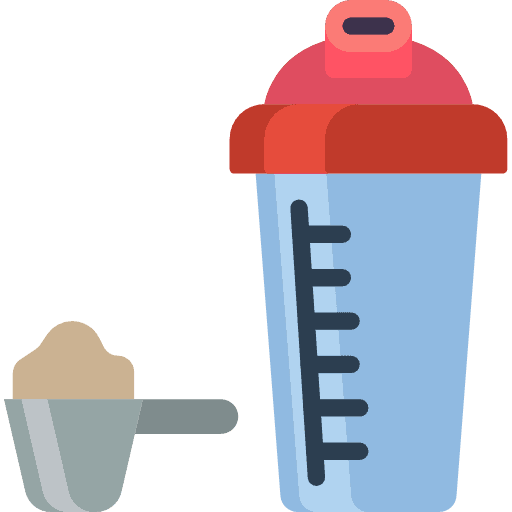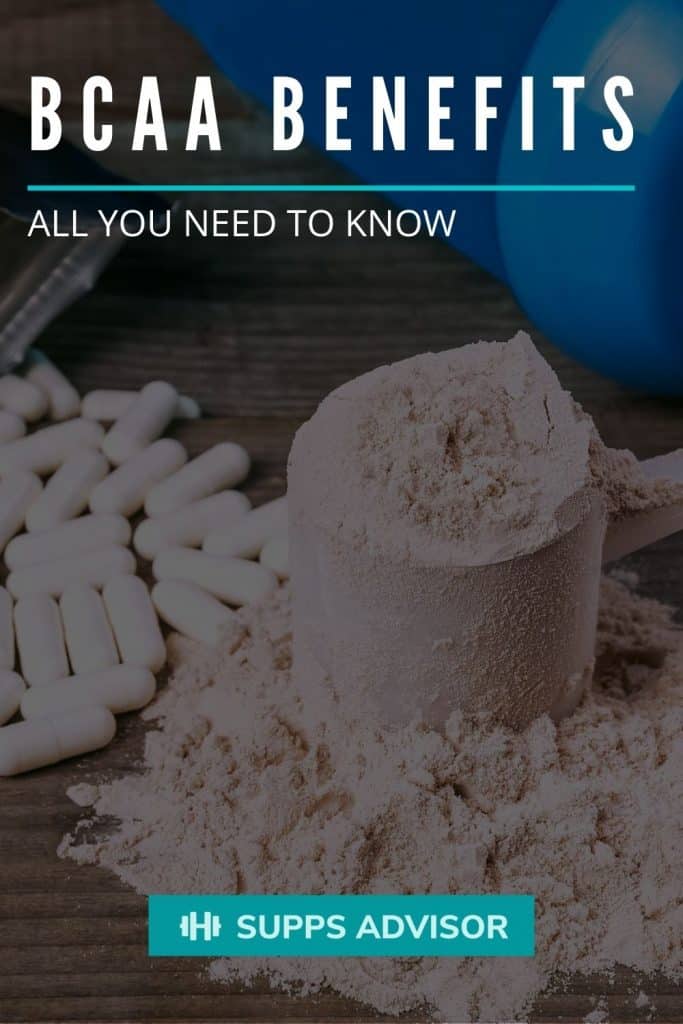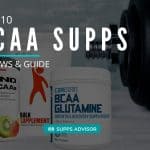If you’re like me, you want to put only the highest-quality products into your body.…
TOC
BCAAs: When? Why? And How?

01/21/2020 · 12 min reading
I remember when I first began working out regularly. I was finding myself intensely fatigued, and I was not getting the results that I would like to despite my hard work.
I realized that something must be missing from my diet and exercise regime, so I took to consulting with a personal trainer.
He recommended BCAA supplements to me.
At first, I was thinking, “What is BCAA?”
Fortunately, I was not disappointed by this recommendation!

What is BCAA?
BCAA stands for Branched-Chain Amino Acids. The “branched-chain” relates to the shape of their chemical structures.BCAA consists of 3 amino acids called leucine, isoleucine, and valine. To further understand what BCAAs are, the best thing to do is to break it down into digestible bits of information.
The Role of Amino Acids
Let’s begin with amino acids. Amino acids are organic compounds that our body uses to create proteins. Proteins are one of the essential compounds in our bodies. Protein has a multitude of uses, including body tissue construction and repairs, forming enzymes, and regulating hormones.
Bones, muscles, connective tissues, and blood all rely extensively upon proteins. Essentially, we are building an upward pyramid. Amino acids are building blocks for proteins, and proteins are the building blocks for our bodies.
After digesting protein, it breaks down into amino acids, thus continuing the cycle.
There are a total of 20 amino acids. These 20 compounds split into categories of essential, nonessential, and conditional.
Essential amino acids cannot produce naturally in the body. These compounds come from the foods we ingest. The three amino acids in BCAA are essential.
Nonessential amino acids produce in our bodies without needing to come from our diet.
Conditional amino acids only show up in the case of illness or stress when the body is needing extra assistance.
The trio of amino acids that make up BCAA is under consideration as potentially vital to the anabolic reaction occurring naturally. The anabolic response increases protein production within muscles, stimulating muscle growth and performance.
Leucine
Leucine itself has multiple significant roles. In BCAA, leucine is considered the most crucial compound out of the trio. After an intense and sweaty workout, leucine goes to work to prevent muscle breakdown due to the temporary stress you place on your body.
From there, leucine continues to build your muscles, trigger growth hormones, and regulate metabolic functions. Research suggests that this compound aids blood sugar regulation as well.
Isoleucine
Isoleucine is much like leucine as far as how it regulates muscle tissue and hormones. One primary function of this compound is the role of maintaining energy levels.
Valine
Finally, valine contributes its own set of benefits. For instance, valine improves the immune system and cognitive functions, along with suppressing your appetite. When you need to build your endurance, valine comes to the rescue to quicken muscle tissue recovery metabolism. This aspect is especially significant and valuable for athletes and bodybuilders.
Thanks to the collision of these three amino acids and their functions, sports nutrition has adopted it as a staple item for optimizing athlete training and recovery.

BCAAs Benefits
If you’re wondering how BCAA can fit your unique needs, fear not. In this section, we will discuss the primary proven valuable BCAAs benefits.
Increasing Muscle Growth

One of the most popular reasons that people decide to use BCAA is for muscle growth. Due to the role of amino acids in protein synthesis, supplementing BCAA with other dietary sources of protein encourages muscles to heal and build new tissue.
If you remember our building block pyramid, amino acids form the base of the pyramid, and protein forms the next level. Once those amino acids produce protein, protein begins synthesizing the muscle tissue for the final level of our muscle pyramid.
Maintaining Muscle Mass and Preventing Muscle Wasting
There is a massive amount of medical conditions that make muscle mass hard to maintain or lead to muscle wasting. Fortunately, BCAAs have proven beneficial in these medical situations.
A common issue among chronic conditions is malnutrition. Filling in the absence of protein consumption or absorption using BCAAs helps maintain muscle mass in cases where chronic conditions would otherwise interfere with these essential building blocks.
When medical conditions cause your muscles to begin wasting, it is due to protein synthesis not happening fast enough to replace the protein that your body naturally breaks down.
BCAAs amp up your protein synthesis process while simultaneously slowing the break down of protein.
TIP: Using BCAA during weight loss will allow you to maintain muscle and get rid of excess fat.
Isoleucine pulls a lot of weight in this area. This specific amino acid is proven to slow muscle wasting similarly to the other 2 compounds in BCAA, but it has other proven benefits for chronic conditions as well.
For chronic conditions that cause significant muscle protein loss, isoleucine prevents muscle loss by quickly closing the protein deficit.
Using BCAA to balance out your protein synthesis and break down rates will maintain your muscle mass or potentially begin to increase your muscle mass bit by bit depending on the effects of your medical conditions.
Decreasing Muscle Soreness

veryone that begins a new workout regimen experiences the inevitable sensation of muscle soreness. This sensation is called delayed onset muscle soreness (DOMS), and it can last for up to 72 hours. Although DOMS isn’t fully understood, the current theory is that DOMS is due to slight muscle damage. Since BCAA works to decrease muscle damage and promote tissue health, the severity of the dreaded muscle soreness could lessen significantly.
Reduce Exercise Fatigue and Improve Endurance
When exercise is prolonged, your muscles begin to pull BCAA from your bloodstream. When this happens, these amino acids have trouble fighting off the flow of tryptophan that moves to your brain.
You have likely experienced sleepiness on Thanksgiving after a hearty helping of turkey. The reason behind the post-turkey fatigue is the tryptophan that is in turkey.
BCAA works to block the uptake of tryptophan. If you add BCAA to your exercise regime, there will be more amino acids left in your bloodstream to prevent exercise-induced fatigue.
The previously mentioned quality of valine, muscle tissue recovery, works in tandem with the other amino acids in BCAA to improve exercise endurance.
Lower Blood Sugar Levels
Although it isn’t fully understood yet, some studies suggest that BCAA can reduce blood sugar levels. This effect happens when leucine and isoleucine increase insulin production, causing your muscles to use more blood sugar from your bloodstream than it otherwise would.
Enhance Weight Loss and Decrease Body Fat

On top of the numerous muscle benefits, BCAAs can work for weight loss and burning fat.
Studies have shown that the average consumption of 15 grams of BCAA per day may be approximately 30% less likely to become overweight.
Another previously mentioned attribute of valine is the potential to suppress your appetite. When combining this quality with a healthy diet, you can curb your cravings and implement portion control.
Help with Liver Disease
When used properly, BCAAs are linked to positive benefits in patients with liver diseases.
A recent study review concluded that a BCAA supplementation improved liver function and reduced the risk of complications in patients going into liver surgery.
In other cases of liver failure, one common complication is hepatic encephalopathy. Another study review found that adding BCAA supplements has the potential to lower the severity of complications such as hepatic encephalopathy.
The decreased fatigue and prevention of muscle weakness soothes patient symptoms, along with valine’s ability to improve insomnia and increase sleep quality.

How to Take BCAA
The key to optimizing your results from BCAA is understanding when to take it and what dosage you need. Answers to both of these questions depend on what outcome you desire.
Best Time to Take BCAA

For most people, drinking a mixture of BCAA powder with your chosen liquid and consuming it 1-3 times per day is effective. These 3 times consist of pre-workout, intra-workout (during your workout routine), and post-workout.
Frequency of dosing is potentially an enhancing factor for BCAA consumption. Splitting your total daily amount into multiple small doses throughout the day gives your body a steady stream of BCAAs as compared to taking larger doses less frequently.
If you consume your BCAA powder mixture once a day, it should be 30-40 minutes before your workout or directly after your workout. BCAAs absorb into your bloodstream quickly, hitting peak levels by the beginning of your workout in this scenario. If you consume a high-protein meal or supplement within a couple of hours before your workout, the timing for your pre-workout dosage may not be as important.
Consuming your BCAA supplement before your workout works to delay your fatigue, give you energy, and help your body burn fat. If you prefer to exercise before your morning meal, the fasting state your body is in will help you absorb the BCAAs better and prevent muscle breakdown.

In situations of extreme muscle training, pairing leucine with protein and carbohydrates of some form around 1 hour into your training session increases your benefits.
New research suggests that the window for maximum benefits from protein and amino acid intake is much longer than the previously assumed 45-60 minutes. Thanks to this information, we can deduce that intra-workout dosing can optimize endurance and sustain your results throughout extended periods of training.
BCAA ingestion post-workout aids muscle recovery and speed up the protein synthesis process. This timing can ease your delayed onset muscle soreness and add to the potential for muscle growth.
For weight loss, pre-workout use combined with an intra-workout dose aids your muscle strength while increasing the amount of fat you burn.
BCAA Dosage
While there is no hard-and-fast rule for dosages of BCAA, there are a few recommendations to give a general idea. For those with a moderate to an intense exercise routine, a fair guideline to follow to calculate your total daily dosage is 91 milligrams per pound of body weight (or 200 milligrams per kilogram).
Once you have the sum of your daily milligrams, convert that amount into grams for your final daily dosage. As an example, if you weigh 165 pounds, then your daily dosage would come out to approximately 15 grams.
Recent studies have set an approximate daily recommendation, whether these BCAAs are consumed through diet or supplements. Healthy adult women should consume a minimum of 9 grams per day, while men should consume a minimum of 12 grams.
The recommended ratio for leucine, isoleucine, and valine, would be 2:1:1, respectively. Assuming you are taking a single dose of 5 grams, you would have 3 grams of leucine, 1 gram of isoleucine, and 1 gram of valine.
“The more knowledge you have, the more you’re free to rely on your instincts.”
Arnold Schwarzenegger
For bodybuilders, an ideal amount of leucine would be 16 milligrams per kilogram of body weight, with the same amount applying to valine. Isoleucine should be 10 milligrams per kilogram.
For those using whey protein along with BCAA, should be an 80:20 ratio of concentrate and isolate, respectively. Part of the relevance of this ratio is because of whey isolate containing small quantities of BCAA. If you use both products based on guidelines, the amount in whey isolate generally won’t affect your daily dosage.
Following the manufacturer guidelines on the supplements that you purchase is generally a safe bet. Nevertheless, understanding how your unique factors play into is crucial to optimizing your results and preventing yourself from overdoing your supplements or having adverse reactions.
To begin seeing noticeable results from your BCAA supplement, be sure to take your supplements consistently. Results will take more than 10 consecutive days to show up at all.
These days should include the days that you do not work out as well. On rest days, BCAAs still benefit you by assisting the muscle recovery and synthesis processes. Ultimately, the longer you routinely consume your BCAA supplements, the more significant the results will be in the long run.

Main Food Sources of BCAA
As a whole, any food containing protein is going to have BCAAs. If you are looking to tank up your diet with high-protein foods packed with BCAAs, here are some general recommendations.

In descending order, here are the food sources that are the most packed with BCAAs.
- Meat, poultry, and fish
- Beans and lentils
- Milk
- Eggs
- Pumpkin seeds
- Quinoa
- Nuts
If you are looking to boost one specific amino acid, or if you otherwise prefer to monitor your intake of each one, here is a further breakdown.
To increase your leucine intake, enrich your diet with brown rice, wheat, beans, and nuts.
Excellent sources of isoleucine include chicken, fish, almonds, and eggs.
The best sources of valine are dairy products, soy, and peanuts.

Possible Side Effects
Since BCAAs are natural compounds, the consumption of supplements is generally safe. Occasionally mild side effects are experienced, such as headaches or gastrointestinal upset. Gastrointestinal symptoms may include bloating, nausea, vomiting, and diarrhea.
Mostly, potential side effects depend on other conditions or circumstances involved.
For women who are pregnant or breastfeeding, there is not enough evidence to understand the safety or effectiveness of BCAA supplements. The safe and recommended bet, in this case, is to avoid supplementation.
Amyotrophic Lateral Sclerosis (also known as ALS or Lou Gehrig’s Disease) causes progressive muscle weakness. Although consuming a plentiful amount of muscle-building amino acids would seem to be a perfect idea, avoid the use of these supplements with this disease. BCAA supplements link to lung failure and an increased death rate in ALS patients.
In rare cases, someone’s body may not be able to break down branched amino acids fully. This issue presents itself in Maple Syrup Urine Disease (or branched-chain ketoaciduria). Consuming BCAAs with this disorder can cause seizures and severe physical retardation.

It is imperative to avoid BCAA supplementation for up to 2 weeks before surgery whenever possible. Due to the effects of BCAAs on blood sugar, maintaining your levels during an operation can be difficult. If you are unable to cease supplementation in time for your surgery, make sure that you inform your surgeon so that they can act accordingly.
Chronic excessive alcohol intake while supplementing with BCAAs is linked to liver damage. Among these liver diseases is Hepatic Encephalopathy, which causes brain damage via fluid buildup surrounding the brain.
If you have any doubts or questions about the possible effects of BCAAs on a medical condition that you have, always consult a physician first.

Summary
Pick up your protein and your BCAA shake! There’s nothing to lose and plenty to gain.
BCAAs are highly beneficial whether you want to lose some weight, maximize your regular gym routine, boost your athletic performance, or gain muscle mass. For the vast majority of people, BCAAs are entirely safe and effective.
Scientists continue to test the potential benefits of BCAA supplements and uncover more information, so BCAAs may be significantly more beneficial than we currently believe.
BCAAs Explained in 60 seconds

Alex is a former Personal Trainer and the go-to guy when it comes to his blog - SuppsAdvisor.com. Every piece of content is thoroughly checked, rechecked, and then published by Alex!
He is very much into sports activities such as tennis, skiing, surfing and of course working out.
His motto: be active, healthy, and happy!
